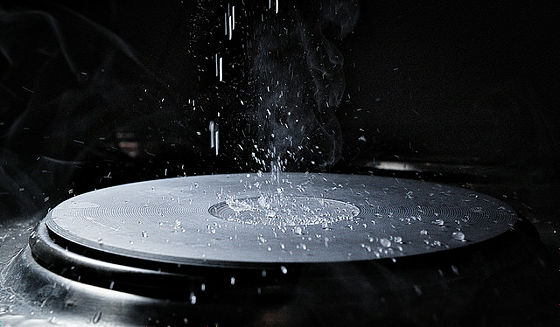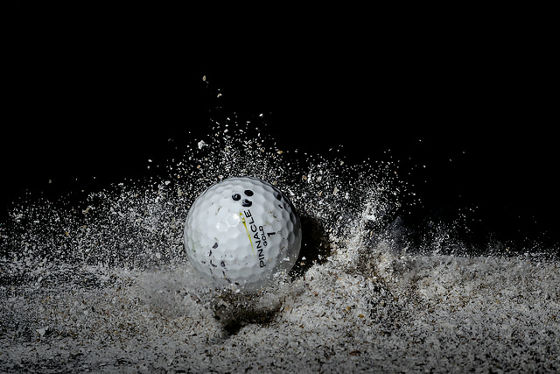Scientists demonstrate that the resistance of water drastically decreases as iron balls covered with air bubbles sink into water

When iron balls are dropped into a pool with water, usually iron balls will not sink at a stroke by receiving the power of water resistance, and will fall to the bottom at a certain speed. However, in a study conducted by a research team, when iron balls with special surface treatment were dropped into water under certain conditions, the iron balls were wrapped in a layer of air like bubbles, It has been demonstrated that it will sink at a fast speed with almost no water resistance.
Hydrodynamics researchers demonstrate objects sinking in water with zero drag
https://phys.org/news/2017-09-hydrodynamics.html
This research is being conducted by scientists such as the University of Melbourne and King Abdullah University of Science and Technology in Saudi Arabia. At first glance the experiments performed are simple and it is meant to drop an iron ball with a diameter of 2 cm into a pool with a depth filled with water. However, if a certain condition is satisfied, the iron enveloped in air bubbles The ball sank to the bottom of the pool as it was, the speed was 10 times higher than the normal calculated value. In other words, the phenomenon that the "resistance of water" which should normally be found is greatly reduced by the air bubbles surrounding the iron ball was confirmed.
It is a simple experiment just to drop an iron ball in water, but in fact the research team said that he spent many years to confirm this phenomenon. It seems that the difficulty was where we found the conditions that create this phenomenon. The research team prepared two kinds of steel balls "prepared in advance to be heated to a high temperature" and "to be subjected to superhydrophobic treatment on the surface", and the experiment was started.
The research team heated the steel balls to a high temperature of 400 degrees Celsius first and further warmed the water that sinks the iron balls to 95 degrees Celsius just before boiling. When the iron ball is dropped in water in this state, the 400-degree iron ball touches 95 ° water, the water on the contact surface boils in a moment and turns into a gas, and water vapor is generated. Then, this water vapor creates a thin layer between water and iron ball, preventing water and iron ball from touching. And it was confirmed that this phenomenon occurs continuously as the iron ball falls, and the water resistance greatly decreases.

In this phenomenon, when water is dropped on a frying pan heated to a high temperature, water droplets float up due to the generated water vapor, so that water does not readily evaporateLeiden Frost effectWhat is going on in the water. Water is overheated by the iron ball, but the chain reaction that the water and the iron ball hardly contact with each other is caused by the steam generated instantly, which means that it continues.

ByJesús GR
Another iron ball has been subjected to "super hydrophobic treatment" to repel water on its surface. This is the same as what is called so-called "water repellent processing", and objects treated with this treatment will slip down without stopping even if water is attached to the surface. The research team is being sold as a water drop prevention article of a side mirror of an automobileGarako mirror court ZEROBy spraying it on an iron ball and applying water repellent treatment, it is creating a low resistance state. Dr. Derek Zhang, a member of the research team, says, "The superiority of this method is that it is effective even if the water is at the same room temperature as room temperature."
Dr. Ivan Bakareeski and Dr. Seguldur Troodsen of King Abdullah University of Science and Technology says there are other ways to reduce water resistance. For example, it is well known that a recess "dimple" on the surface of a golf ball has the effect of reducing air resistance, and by releasing a bubble of fine air from the front of an object moving in water, the water resistance It is also known to decrease. The phenomenon that the resistance decreases by these methods is realized by changing the flow of "fluid" such as water and air around the object. What is important here is the existence of the "boundary layer" existing between the object and the fluid.

ByPeter Drach (aka Pete Dragomir)
In the first experiment conducted by the research team on iron balls, we were able to create a "boundary layer" of about 1 mm of water vapor, but the resistance of water to be alleviated is only about 10 to 20% about. To realize even more resistance reduction, the research team decided to push this method forward. Next, the research team advanced the change of the air layer due to the height of dropping the iron ball. Then, it became clear that there is a region of height where the foam of the most successful air is created and the bubble is maintained longer.
In the world of physics, "Resistance does not work on objects when moving an object constantly and linearly in a stationary ideal fluid"Darrenberg's ParadoxThere is a famous paradox called. It has been extremely difficult to prove the flow of a fluid to an object with a complicated shape such as a golf ball by a mathematical formula so far, but with this experiment, it was found that the movement of a fluid with respect to a sphere having a simpler shape It will be possible to express with a simple mathematical formula theoretical model. This is expected to further advance research to reduce the water resistance of ships.
Even now, although technology to reduce boundary layer by flowing minute bubbles of air along the surface of a ship to reduce the resistance is developed, super-hydrophobic treatment of the surface of the ship bottom causes thin air It seems that it will become possible to aim for further resistance mitigation by making a membrane of.
Related Posts:
in Science, Posted by darkhorse_log







